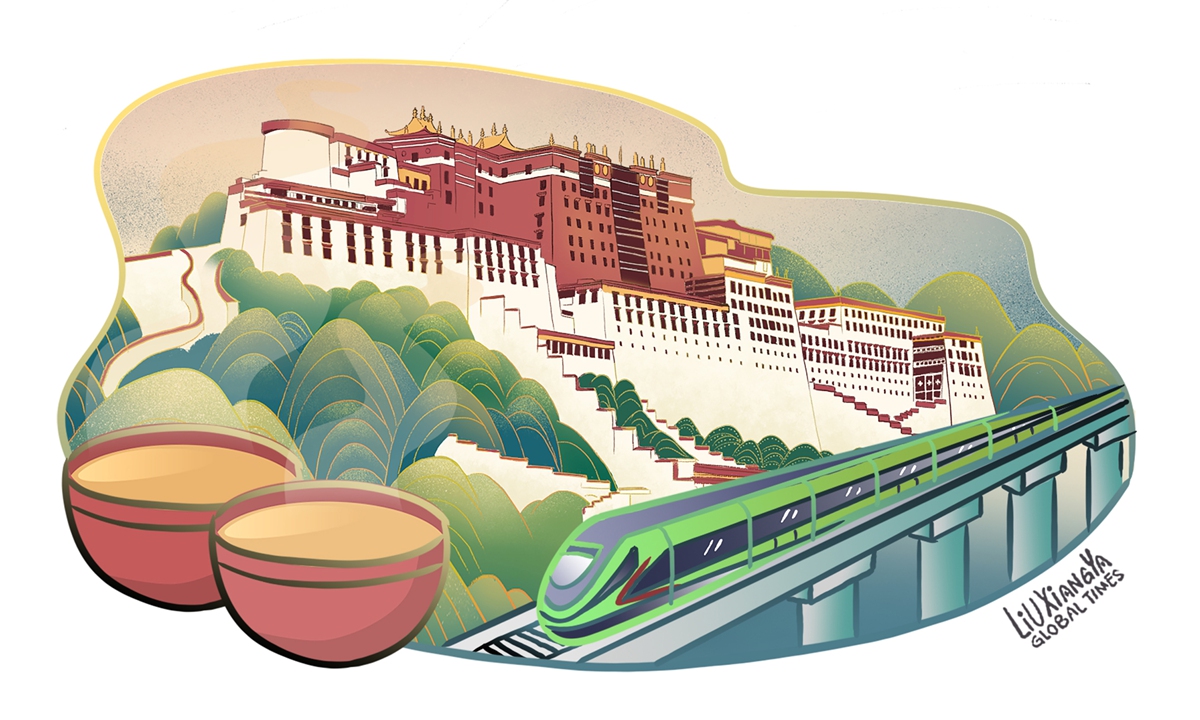
Illustration: Liu Xiangya/Global Times
As I was getting ready to listen to a brief on the weeklong Southwest China's Xizang Autonomous Region tour I was about to take at the multicultural hall of the Jianguomenwai Diplomatic Residence Compound in Beijing, my co-worker Mi Tian jokingly cautioned me: "Birat, don't run away from Xizang just because your home is closer than Beijing."
Having traveled the "roof of the world" for a week, I didn't need to "run away" in search of my home in Nepal as I found Xizang was just like my home. My friend Tan Xiaoren, a Chinese from Malaysia, has told me some useful Chinese words. In Xizang, I was telling him the meaning of "Tashi Delek," a greeting.
On October 6, a dinner was hosted for us by the Xizang regional foreign affairs office at the Phin Tsok Ge Don Restaurant in Lhasa. During the happiest dining hour, all of us were served sweet milk tea. Among the two dozen plus friends from 20 plus countries, we two Nepalese (me and my friend Manju) were sipping the tea we enjoy in our everyday life. However, for other foreign friends, it was a new experience. Deputy head of foreign affairs office of the Xizang Autonomous Region Yi Lin and the region's noted public intellectual Lo Ten sang a Nepali song along with Tibetan songs. Other friends were surprised at seeing them sing a Nepali song.
When we were greeted at the Nyingchi Airport on October 3 by local officials with the gift of scarves, all out other friends greeted them back with greeting gestures. Interestingly, we two Nepali journalists greeted them by presenting our own scarves. Our friends were amazed to see how we greeted each other. For us, though, the Xizang greeting is familial as it shares some commonalities with the Himalayan communities of Nepal. These are some of the few examples of our recent memorable tour to Xizang.
On October 4, an open-air stage at the Dayhello Hotel of Lulang held an artistic performance which included a song titled "Welcome to Pokhara," a tourism town in Nepal. It was the only song in a foreign language because Pokhara of Nepal and the Nyingchi of Xizang are officially sister cities.
I was more than happy to make my first footfall in Xizang. A journalist named Li Guangqing asked me: "Have you ever been to Xizang?" To which I replied, "I have been to Xizang many times in my imagination. But, this is my first time in reality." I did not say this as a joke. It has historical legacy. Nepal's Great Poet Laxmi Prashad Devkota's iconic epic Muna Madan is the story of a Nepali man coming to Xizang. There are many Nepali sayings popular among ordinary Nepali people. For instance, there is "Lhasa janu kutiko bato," which translates as head to "Lhasa via Kuti," a popular pass. Another saying goes: "Lhasama sun chha kaan mero buchchai," which roughly translates as "There is gold in Lhasa but I don't have an earring." This saying describes Nepal's historic trade linkage with Xizang and its impacts among the ordinary people.
Nepal has three international and three bilateral border crossings with Xizang together with a dozen plus local passes for people's movement. This physical attachment is reflected in the cultural and emotional attachment among people from both sides of the Himalayas. For instance, when I saw an English-speaking lady at the Botai Nyingchi Grand Hotel in the Bayi district, I greeted her with "Tashi Delekh." She replied with "Namaste," the Nepali greeting. I later learned that she was from Xigaze, the second largest city in Xizang and which is in close proximity with Nepal. She had not been to Nepal. Still, she could greet in Nepali. This speaks volumes about cross-border camaraderie and cultural communication.
Nepal has 1,414 plus kilometer long border with Xizang. Nepal is the only nation with a diplomatic presence in Xizang. This is another reason for Nepal's attachment to the region.
In the seventh century, Songtsan Gampo, the then king of Xizang, had married the Nepali princess Bhrikuti as his first wife.
This history is well-written in the Jokhang Temple of Lhasa, which was listed as a UNESCO World Cultural Heritage Site in 2000. UNESCO also says that the Potala Palace, another World Heritage Site, has architecture that is a mixture of Chinese, Tibetan, Nepali and Indian.
Having traveled from Nyingchi to Lhasa, Lulang to Qiangna, and visited the touristic treasures around their vicinity, I saw Xizang as a home away from home. Lhasa, the sister city of Kathmandu, hosts thriving Nepali traders, including the recent awardee of the fifth edition of My China Story, which made me feel at home.
This time, I traveled by the bullet train from Ngingchi to Lhasa. However, in the future, I want to take a similar journey from Kathmandu to Lhasa. This is possible as Nepal is a BRI partner country and the China-Laos railway is an exemplary railway.














